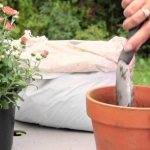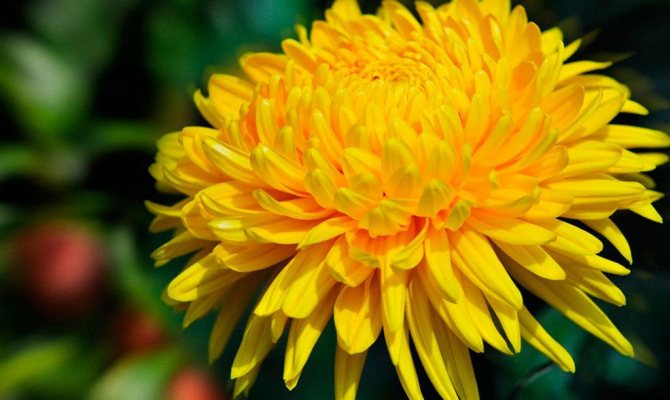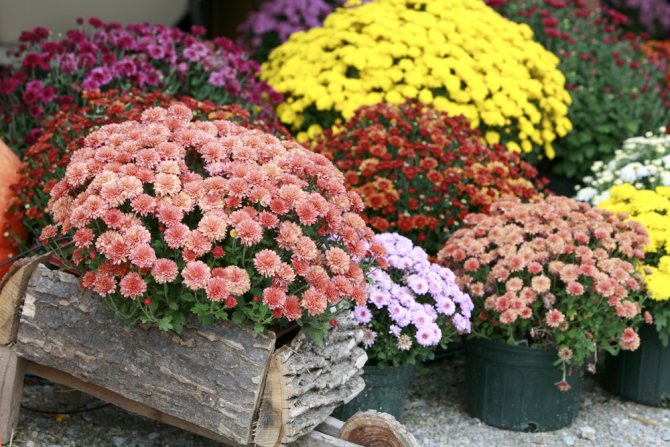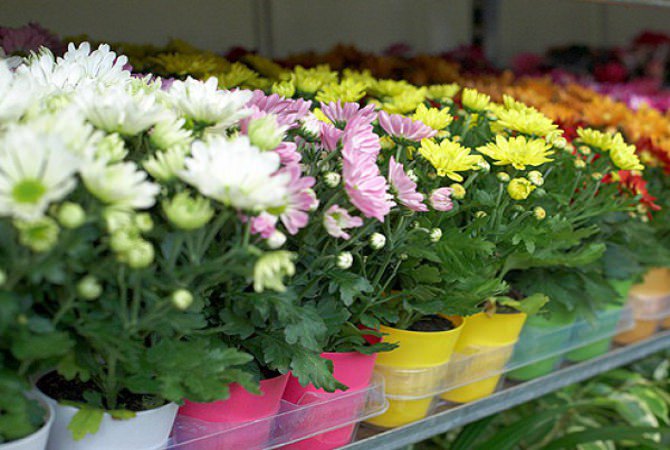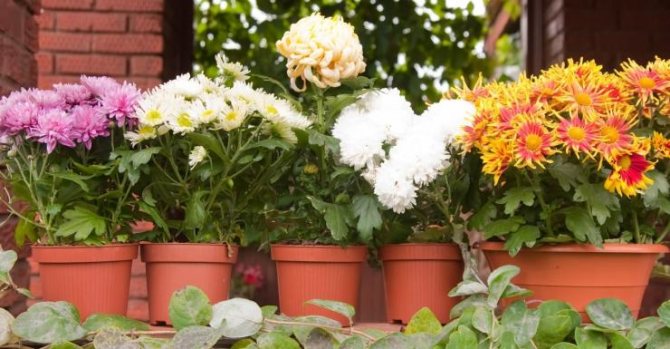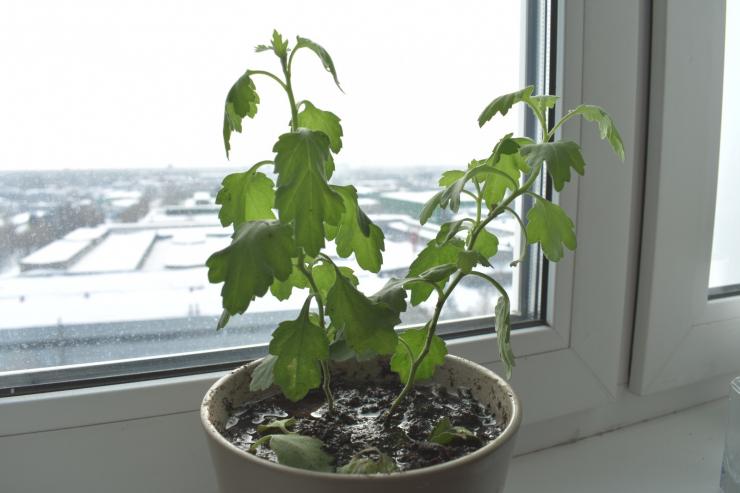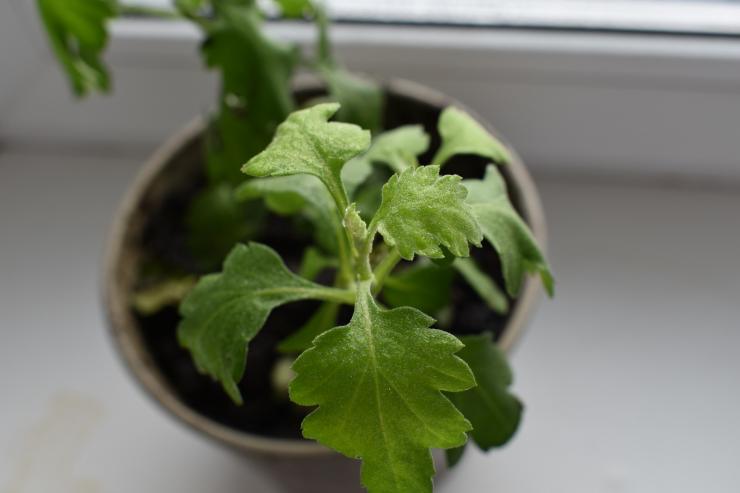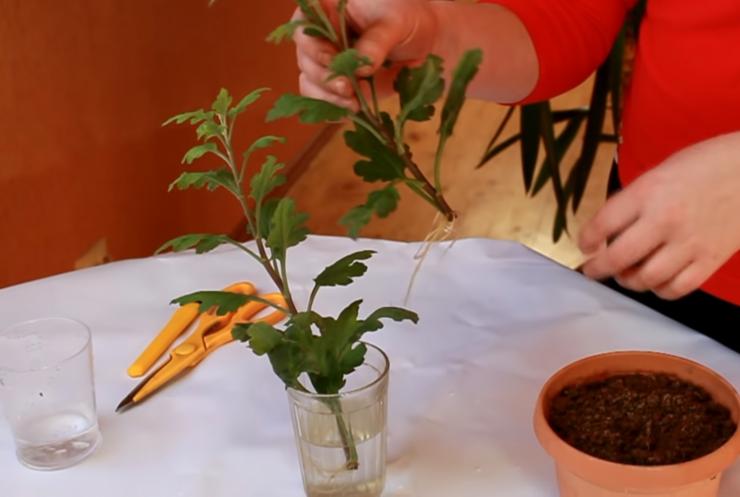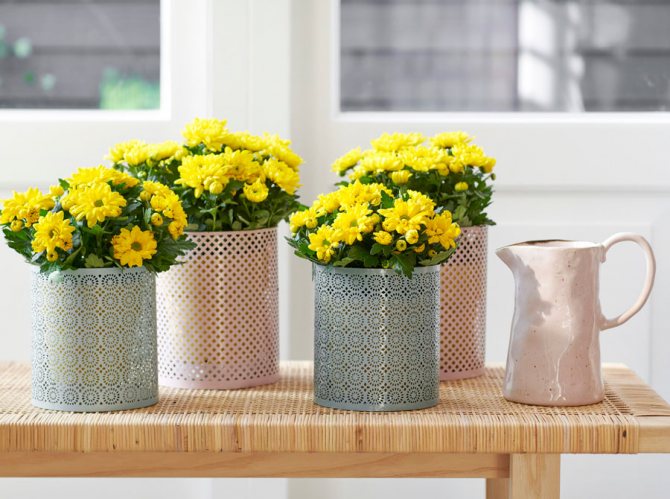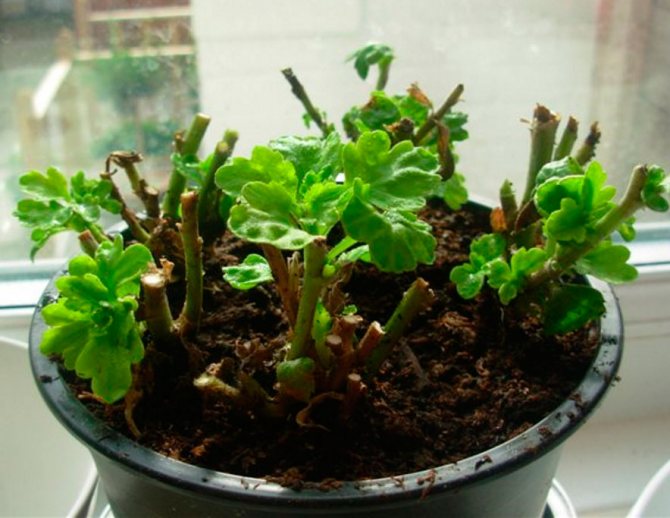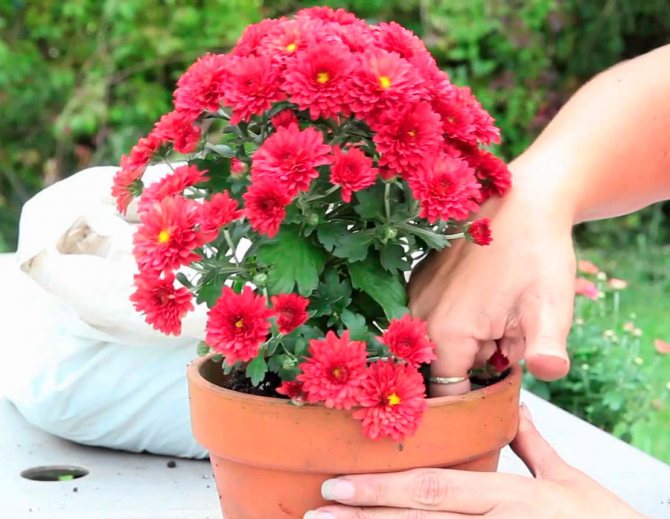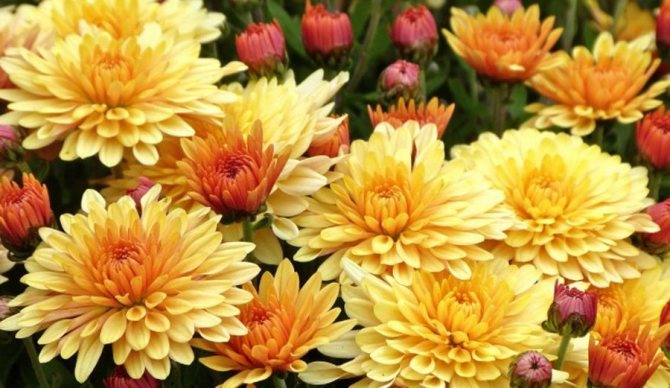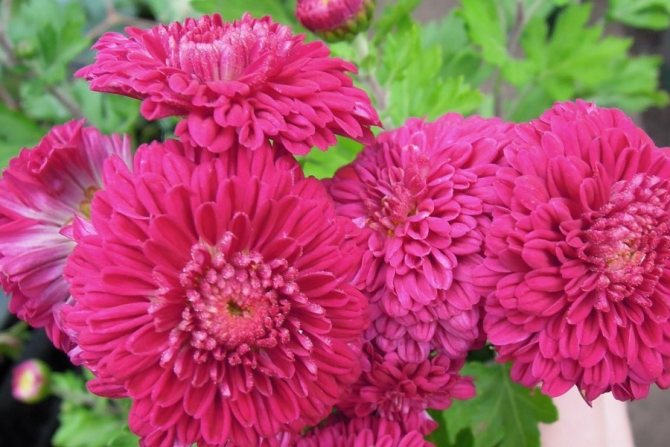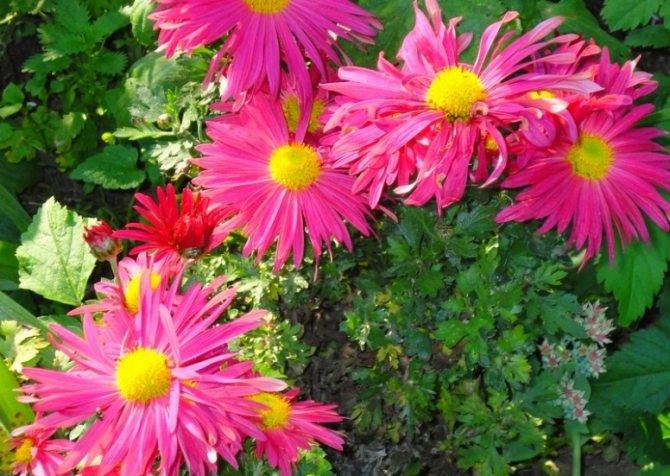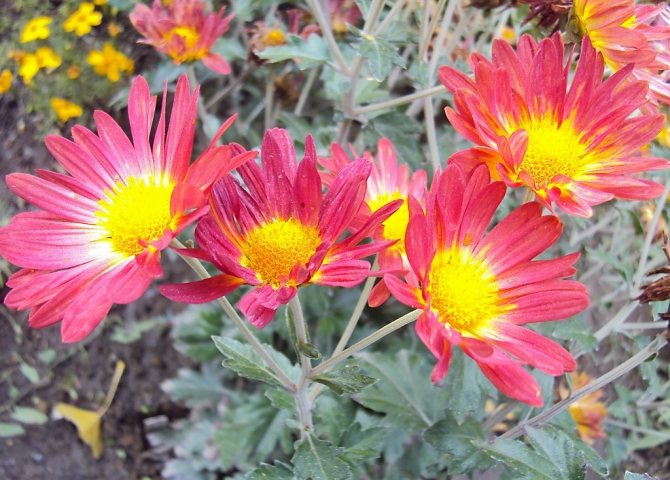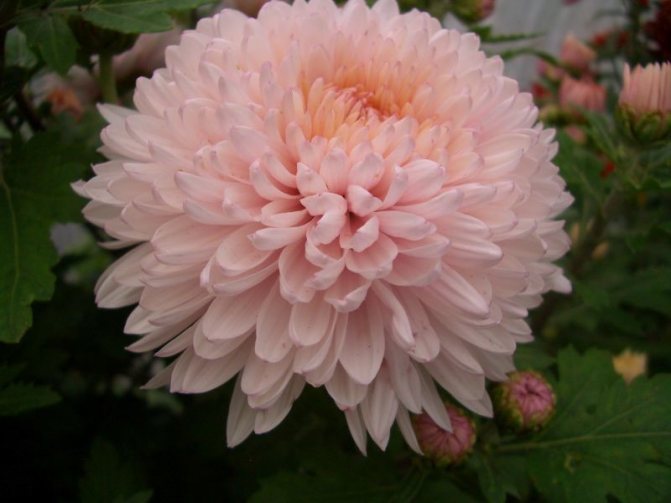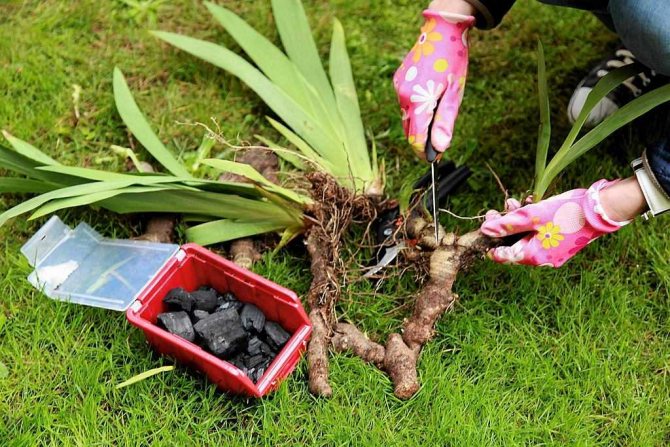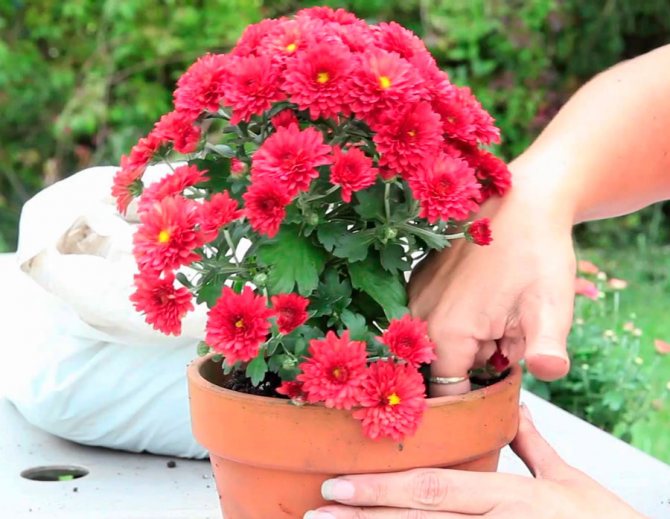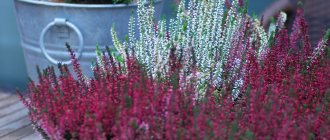The herbaceous annual or perennial flowering plant chrysanthemum (Chrysanthemum) is a member of the Asteraceae or Compositae family. This genus unites about 30 species, their representatives are found in zones with a temperate and cool climate, with most of the species growing in Asia. Chrysanthemum has been cultivated by gardeners for more than 1,000 years, while the culture appeared on European territory in the 17th century. Most chrysanthemums are grown outdoors, but there are species that grow well both indoors and in greenhouses.
Chrysanthemum flower meaning
When it comes to the symbolism of this flower, of course, the traditions of the Far East, where it was brought from, are taken as a basis.
- in Japan, this plant is considered a symbol of the sun, and its image is even present on the imperial seal of the country, foreign passports. Indicates the fast flow of life and its fragility. In addition, it is a symbol of happiness and long years.
- in China, chrysanthemum is the flower of loyalty, as well as high position and honor. Previously, the image of a flower was present only on the imperial robes.
- in Vietnam, this plant speaks of purity of thoughts and clarity of mind.
Fresh articles about garden and vegetable garden
The best varieties of apples
Pepper seedlings: leaf diseases
Rhododendrons in the Urals care and planting
About the soil mixture and transplanting conditions
Despite the fact that chrysanthemum is considered a garden plant, a special soil is needed for its potted counterpart. It is possible to purchase a store-bought soil mixture, but you can prepare it yourself.
Important: the bright beauty prefers loose soil, but fluffing it up by hand should be done carefully so as not to damage the rhizome.
Before replanting homemade chrysanthemum from a pot into a new container, you should mix the following substrate ingredients:
- sod soil;
- sheet soil;
- humus;
- coarse sand.
It does not matter whether it is spring or autumn replanting, the main thing is that the earth is slightly acidic.
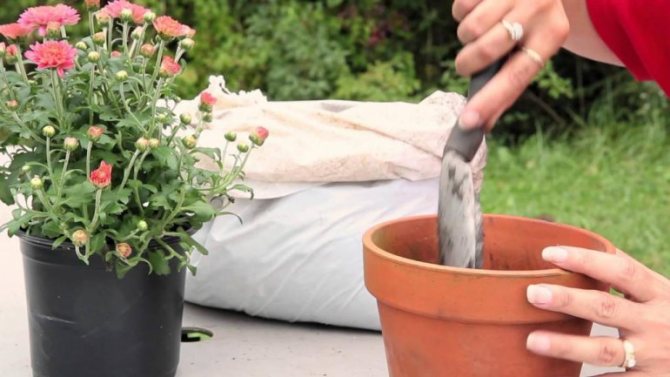
Before use, the soil is heated in the oven for the purpose of disinfection. If the mixture is purchased, this is not necessary.
The growth of the flower is positively influenced by chicken droppings in small quantities. It can be added to the ground from the very beginning. The concentration should be calculated carefully, as the acidity of the soil increases.
The new container should be slightly larger than the old one - a couple of centimeters in diameter. Ceramic products are ideal, but plastic is also used. In any case, there should be drainage holes in the bottom.
Before planting, first, disinfected pebbles or expanded clay are laid out.
Important: during the procedure, the old earthen lump is completely destroyed, and the planting is carried out in an absolutely fresh soil mixture. Only in this case will the plant bloom again.
Potted Chrysanthemum Varieties
Blooming chrysanthemums can be obtained by any date, so it is almost all year round present in the range of flower shops. These are single-headed and bush cultivars of Indian chrysanthemum (Chrysanthemum indicum) and its hybrids (Indicum Grp). Less common varieties of chrysanthemum are mulberry, or Chinese (Chrysanthemum morifolium).But especially spectacular are the small-flowered varieties of various colors of the Korean chrysanthemum (Chtysanthemum x koreanum) of the Multiflora group, which often appear under the name Chrisanthemum multiflora, and are sold in pots or hanging pots, completely covered with abundant inflorescences.
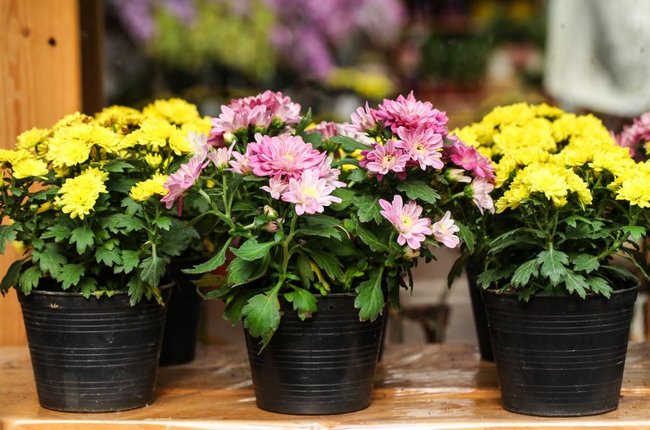

Types and varieties of domestic chrysanthemums with photos and names


It was already mentioned above that dwarf and undersized varieties, as well as hybrids of Korean, Chinese and Indian chrysanthemums, are cultivated at home by flower growers. The Korean chrysanthemum is distinguished by its hybrid origin, however, no one has met the mulberry chrysanthemum in natural conditions. The history of such a plant is very confusing and complex, so it is better not to delve into it. Below will be described those varieties of chrysanthemums that are most popular among flower growers:


- Malchish-Kibalchish... The bush reaches a height of about 0.3 meters, and in diameter - up to 0.6 meters. This variety has a very lush flowering. Its inflorescences are non-double, similar in structure to chamomile, they have a lilac-pink color, and reach about 70 mm in diameter.
- Evening lights... The compact bush reaches a height of about 0.35 meters. The diameter of simple inflorescences is up to 55 millimeters, they are colored red, with a yellow ring around the middle.
- First snow... The height of the bush in such a magnificently flowering variety does not exceed 0.35 meters, while in diameter it can reach up to half a meter. Semi-double inflorescences of white color have a diameter of about 50 millimeters.
- Mascot... The bush is low, only about 0.25 meters. Dark crimson small inflorescences reach about 20 mm in diameter.
- Cheburashka... Compact, hemispherical bushes reach a height of about 0.4 meters. The diameter of the lilac double inflorescences is up to 40 millimeters.
- Barbara... In such an abundantly flowering variety, the bush reaches a height of 0.4 meters. Terry lilac-pink inflorescences with a yellow center are formed so much that sometimes it is impossible to see the foliage because of them.
- Flamingo... The height of the bush is about 0.5 meters. In diameter, the pale pink inflorescences reach about 75 millimeters. The middle of the inflorescence is of a more intense color.
- Pink cream... The bushes do not exceed half a meter in height. The diameter of the densely double inflorescences is about 80 millimeters, they are painted in a pinkish-lilac color, which after a while becomes pink-cream.


- Leaf fall... The height of such a chameleon plant is about 0.45 m. The pinkish-red inflorescences reach about 70 mm in diameter. They can change their color to flesh-yellow.
- Raspberry pompom... This variety is dwarf, the height of its bushes does not exceed 0.3 m. The diameter of hemispherical inflorescences is about 60 mm, they are painted in raspberry-pink color.
- Okishore... The height of a powerful bush is about half a meter, the diameter of the inflorescences is about 80 mm, their color is pinkish-lilac.


- Syaivo... The variety, created by Ukrainian breeders, reaches a height of about 0.6 meters. The diameter of large egg-yellow inflorescences is about 80 mm.
- Apple blossom... The stems of half-meter bushes are powerful and thick. Terry inflorescences reach about 80 mm in diameter, they have a white-pink color.
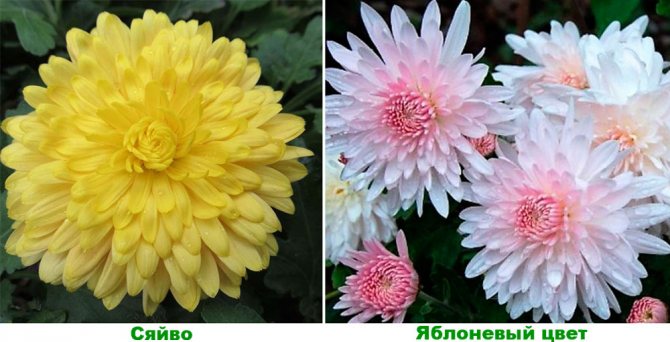

Potted chrysanthemum transplant
The soil for the chrysanthemum should be loose, neutral and rich in nutrients. To prepare you will need:
- sand;
- humus;
- sod land.
All components are mixed in equal proportions until a homogeneous mass is formed. Bird droppings can be added to increase the nutrient content of the soil mix.
Transplanting a chrysanthemum from the garden is as follows:
1. First, you need to choose a healthy shrub that has not been exposed to pests or diseases.
2. At the end of autumn, the bushes are dug up and transplanted into pots. It is important not to damage the root system.
3. After flowering, pruning is carried out and the flower is placed in a place with a temperature not exceeding +6 C. In such conditions, the chrysanthemum should spend the whole winter.
4. In early spring, cuttings are performed. To do this, they are planted in perlite or vermiculite to a depth of 2 cm.
Reproduction methods
Reproduction of chrysanthemum by cuttings


Homemade chrysanthemum is most easily propagated by non-lignified green cuttings. During the preparation of the cuttings, the lateral shoots are cut off from the branch, while the length of the segment should be equal to 10 centimeters. All leaf plates are cut off from the bottom of the segments, and then they are placed in a container with water for rooting. After the roots reach 40-50 mm in length, they are planted in pots, while several pieces are planted in one container at once. Do not forget to make a good drainage layer at the bottom of the pot; use a slightly alkaline or neutral soil mixture. After planting, the substrate is tamped around the cuttings and watering is carried out. It is also recommended to pinch the tops of the cuttings, this helps to stimulate the growth of lateral shoots.
Cuttings for rooting can be planted directly into the soil mixture. They must be covered with a plastic cap on top, which will help create the greenhouse effect necessary for successful rooting. Every day, the cuttings are ventilated, for this, the cap is temporarily removed, do not forget to remove the accumulated condensate from its surface. After the foliage turgor is restored, rooting will be completed, and the shelter can be removed.
Dividing the bush
You can propagate the culture by dividing the bush during transplantation. Remove the plant from the container, carefully remove the remaining soil mixture from the root system and rinse it. Then take a pre-sterilized very sharp instrument and cut the bush into several parts with it, while each division should have several stems and well-developed roots. Treat the cut areas with charcoal powder. Delenki need to be planted in a pot in the same way as adult bushes.
Growing from seeds
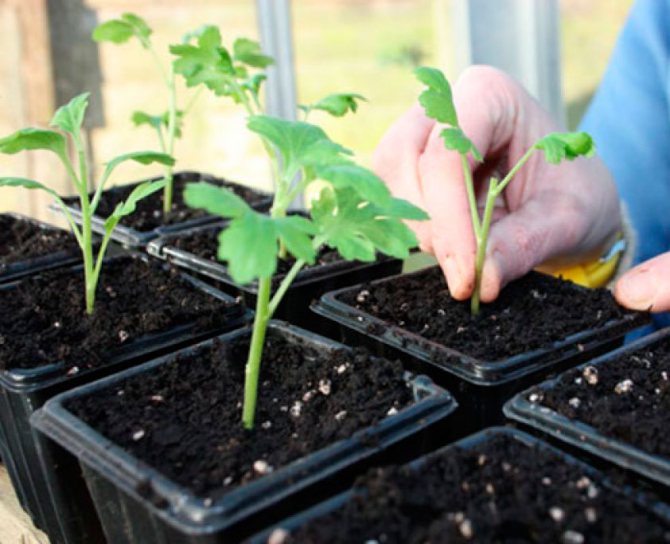

Most often, Korean hybrids and varieties are propagated by seeds. Sowing seeds is carried out in low containers, at the bottom of which they make a good drainage layer. They are filled with a soil mixture, which includes humus and peat (1: 1), before sowing it must be calcined at a temperature of 110 to 130 degrees. For sowing, you can also use a store-bought ready-made soil mixture for flowers, which also needs to be disinfected. It is not necessary to deepen the seeds of perennials into the soil mixture; they are only slightly pressed into the substrate. Crops are moistened from a sprayer and covered with a film (glass) on top. The container with crops is transferred to a warm place (from 23 to 25 degrees), they need systematic ventilation, as well as timely watering. Also, do not forget to remove condensation from the surface of the shelter in time. The first seedlings should appear after 10-15 days, immediately after that the container is moved to a well-lit place. The shelter from the container is not removed immediately, allowing the seedlings to get used to the new conditions. To do this, glass is removed from them every day, increasing the duration of airing gradually, and it is removed completely only when the plants are fully adapted. A pick on individual containers is carried out at the stage of forming 2–4 of a real sheet plate. A drainage layer is poured on the bottom of the cups or pots, and the soil mixture for planting is used the same as for sowing. When diving, try not to injure the roots. To make rooting more successful and faster, the transplanted seedlings are treated with a solution of Epin-Extra or Zircon.The cut seedlings are transferred to a cooler place (from 16 to 18 degrees) and then they are looked after in the same way as for adult chrysanthemums.
Light mode for potted chrysanthemums
Chrysanthemums are crops for which a short daylight hours are enough for abundant flowering. But this does not mean at all that they are content with shaded locations.
Throughout the entire period of active development, including flowering, chrysanthemums need to be provided with the sunniest and brightest locations where the plants will not suffer from midday rays or will be shaded from them by neighboring potted plants.
In winter, chrysanthemums are kept in dark rooms (with the exception of specimens that continue to bloom, which are transferred to the lightest locations of the rooms and plan to be thrown away after flowering).
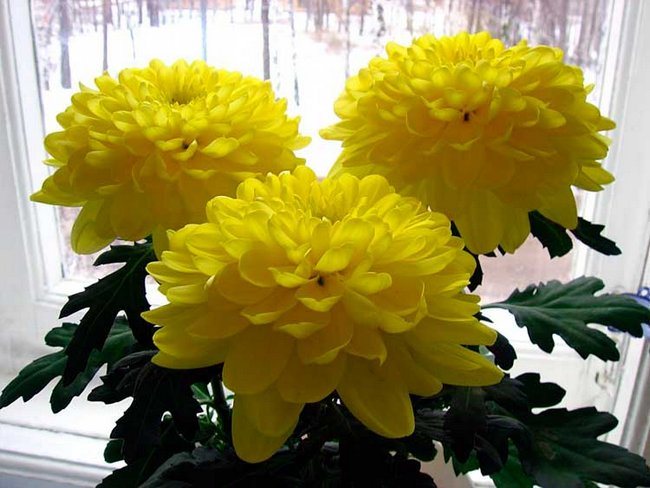

The main problems in growing
During the growing season, plants in apartment conditions, flower growers face various problems, we will consider the main ones.
Why do the leaves turn yellow


If the transplantation after the purchase was not accompanied by proper care of the crop, you can observe the yellowing of the flower leaves.
This unpleasant phenomenon is associated with lack of lighting, lack of moisture in the nutrient substrate or hot air in the room.
Sometimes a fungal infection can be the cause of the discoloration of the leaves.
To prevent drying out, you need to take into account all these nuances.
Chrysanthemum does not bloom why
The lack of flowering on a crop in most cases occurs through a deficiency or excess of natural light.
It should be borne in mind that the chrysanthemum is considered a crop of short daylight hours. When the lighting devices are turned on in the morning and evening, the biorhythms of the flower get confused. Another reason why chrysanthemum does not bloom is excessive feeding.
Watering and feeding chrysanthemums in pots
Watering chrysanthemums in pots is necessary often. Flowers are watered in the evening, after sunset, twice a week. In winter, watering should be reduced. Watering time can be determined by the drying out of the topsoil in the pots. The soil should not dry out, as this leads to yellowing and leaf fall.
Chrysanthemums love water, but too much moisture is also destructive for them. If the flowers are poured, then mold and fungi appear in the ground, and they will begin to hurt. You do not need to pour water into the sump. Watering should be frequent, but not plentiful. You need to take warm and settled water. Regular spraying from a spray bottle or containers with water, humidifiers located near the plants help to maintain the required level of moisture in the air.
Chrysanthemums require regular feeding for full growth and abundant flowering. Ready-made fertilizers are suitable for flowering indoor plants. You can use any multicomponent additives in which the content of nitrogen, phosphorus and potassium is in a ratio of 1: 3: 2. They are used during the growing season and flowering of chrysanthemums. Since November, the plant is not fertilized - abundant flowering ends, and it begins to prepare for winter rest
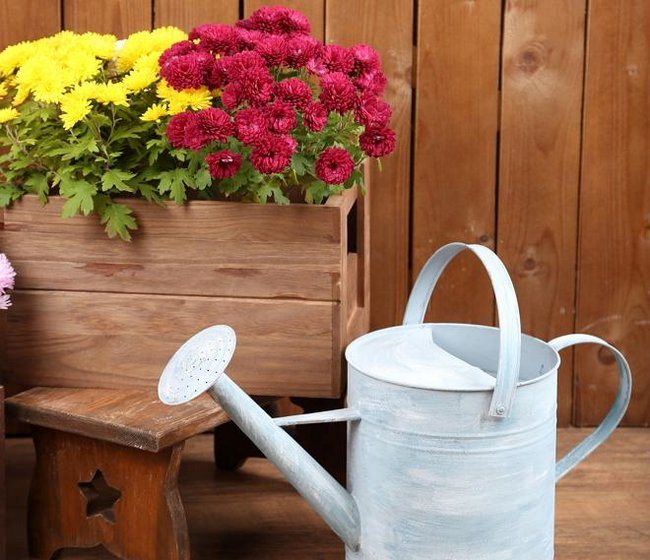

Description of the plant
Chrysanthemum is an ornamental culture that is considered one of the most revered in the East. It is grown not only in greenhouses, but also in the house, for example, on the windowsill. The plant is not tall, has a branchy bush and lush inflorescences, the color of which depends on the particular type of chrysanthemum. In individual pots, it is grown as a perennial or annual crop, has branched strong roots, formed parallel to the soil surface line.


Chrysanthemums grown in pots need high humidity and moderate temperatures
Note! Chrysanthemum leaves are painted in a characteristic light green color, serrated along the edges. The inflorescence is a kind of basket, consisting of a large number of petals.


Buying a room chrysanthemum
Useful properties of chrysanthemum
In addition to its chic, eye-catching appearance, the plant has some beneficial properties. This is about phytoncidesthat are contained in the plant. They are able to clean the air from exhaust gases, various impurities in the air and other harmful substances. Also, when the aromas of a flower are inhaled, the human body has a calming effect - chrysanthemum heals the nerves and relieves stress.
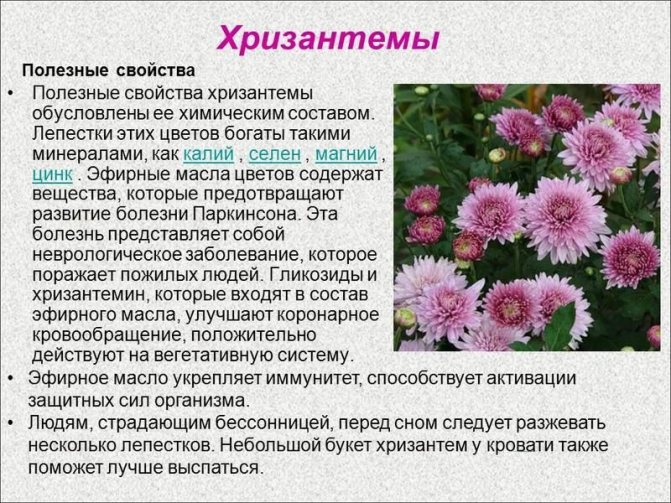

Useful properties of chrysanthemum
Growing features
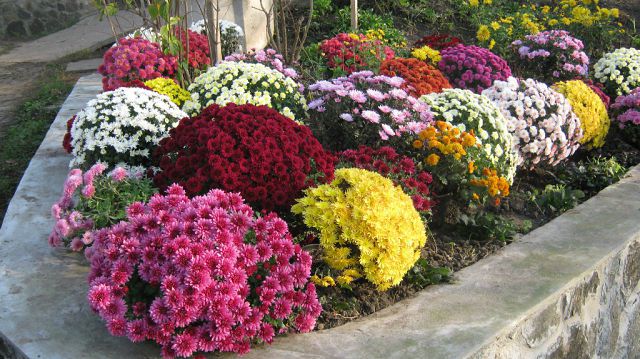

Ball-shaped chrysanthemums in the garden
Chrysanthemum differs from other indoor plants not only in appearance, but also in comfortable conditions that must be provided for its normal development:
- the plant does not like heat, therefore, in the room where it will be grown, it is necessary to observe the temperature regime;
- in extreme summer heat, it is recommended to transfer the pots with chrysanthemums to a cooler place, for example, to the basement... This will protect the plant from drying out;
- use only high quality potting soil... Experienced gardeners prepare it themselves, mixing sand, peat and garden soil. But you can buy ready-made soil in specialized stores.
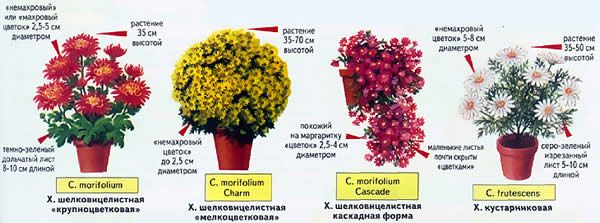

Species available for cultivation
If you are preparing a potting soil mixture with your own hands, then you must decontaminate it before using it. For this, the prepared soil is placed in a preheated oven for 5-10 minutes. Alternatively, the potting mix is disinfected by pouring boiling water over it. For maximum effect, these two methods can be combined.
How to prune a chrysanthemum in a pot
Chrysanthemum should be trimmed after flowering. During this period, it is necessary to remove all regrown stems without affecting young shoots. In the springtime, pruning is also recommended before replanting. The rest of the time, to lengthen the flowering period, you just need to remove the yellowed leaves of the plant.
Fresh articles about garden and vegetable garden
Pepper seedlings do not grow, stands still, what to do?
If the seedlings of cucumbers are very elongated, what to do?
Planting peas in spring sowing: when to sow, how to plant correctly?
Correct care
As soon as you decide on the choice of a variety, after buying a chrysanthemum, you need to provide optimal conditions for it so that the flower can successfully take root in a new place and constantly delight everyone with beautiful and bright flowering. As noted earlier, chrysanthemum is a capricious plant, which is especially evident in the requirements for lighting. But providing good lighting is far from the only thing a florist needs to take care of. It is about temperature control, watering, fertilizing, pruning and other procedures that you will have to deal with during the growing process.
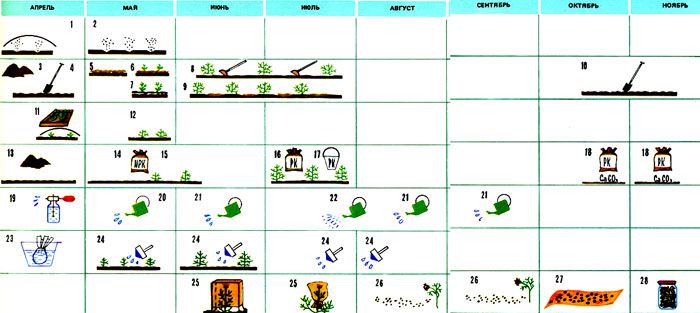

Proper care of chrysanthemum
Lighting
Experts recommend placing flower pots on the windowsill from the west or east. If you want to grow a plant on the north side, then it will bloom very badly or not at all. This is due to the lack of sunlight on the northern windows. Alternatively, the flower can be placed on a balcony where the lighting level is high enough.


Chrysanthemum needs good lighting
Temperature
In order for the plant to grow and develop normally, in addition to lighting, it needs the right temperature. In winter, the temperature should be at least 3 ° C, in summer no more than 22 ° C, and in autumn and spring - from 16 to 19 ° C. Compliance with all of the above parameters will allow you to achieve long and bright flowering.
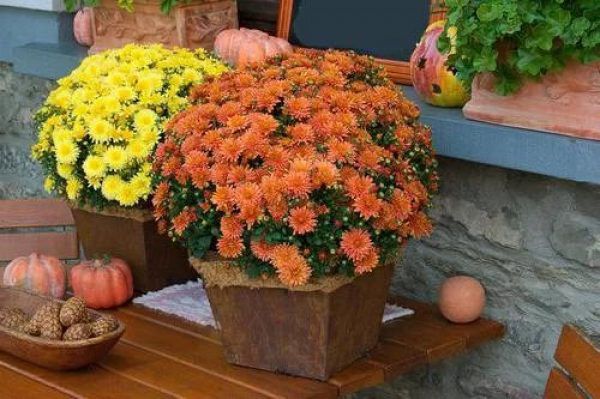

About a suitable temperature for the culture
Watering
Like most houseplants, chrysanthemum needs sufficient watering, but it does not need to fill the plant... It is not recommended to irrigate through the pallet, as it should be done, for example, with cacti.But how do you know when a plant needs to be watered? First of all, you need to monitor the condition of the soil: if its top layer begins to dry out, then you can start watering.
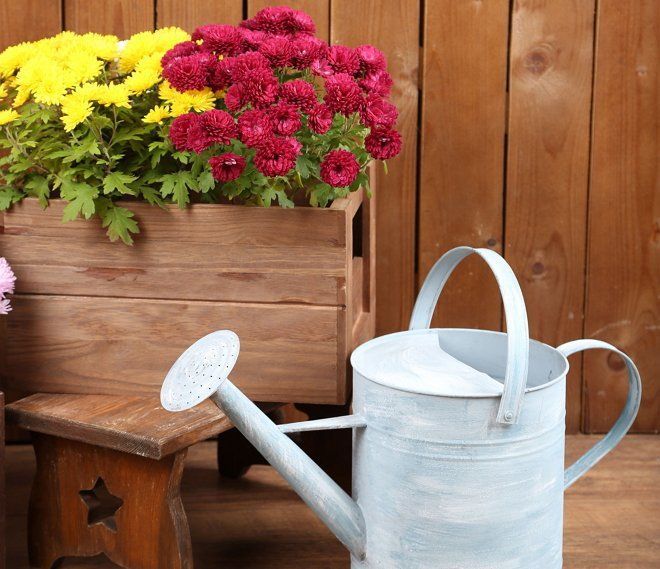

When watering chrysanthemums, it is important not to overdo it.
Priming
It is not necessary to prepare the soil mixture yourself, because store-bought soil for growing ornamental plants is also perfect for chrysanthemums. You just need to make sure that it is not sour, but loose and nutritious enough. But if you nevertheless decide to prepare a soil mixture, then you need to take sand, humus and turf soil as the main components for it. Use a small amount of fertilizer if possible. After preparation, the soil mixture must be disinfected.
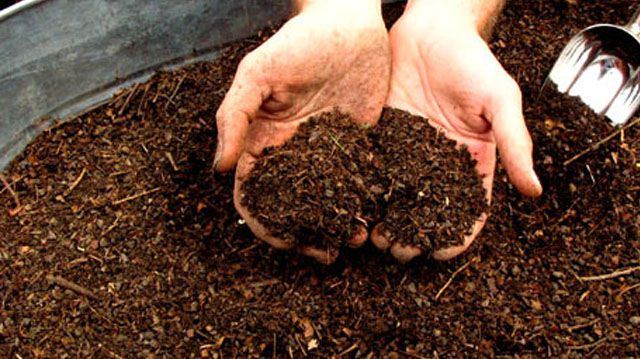

The soil mixture can be prepared by hand
Pot
The container for chrysanthemum must be selected shallow, but at the same time wide enough. This is due to the peculiarities of the development of the root system of plants - they grow superficially. At the very bottom of the pot, carefully lay out the drainage to cover the bottom. This will protect the plant from excessive moisture, which has a detrimental effect on the roots of the plant. Pebbles, small pebbles or expanded clay can be used as drainage.
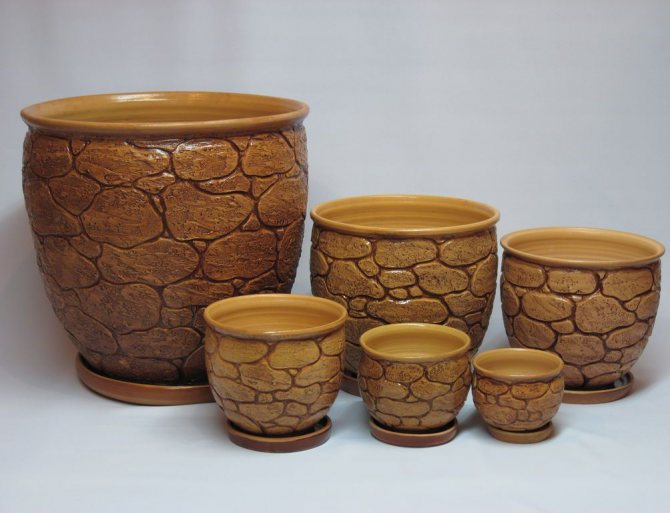

Chrysanthemum pots
Transfer
One of the most critical stages of growing chrysanthemums is transplanting. It must be carried out every year, but if the plants are already adults, then the transplant can be done less often. Some plant species can grow for several years in one place, which does not affect their health and appearance in any way.


As a rule, chrysanthemums are transplanted every year.
Note! Blooming chrysanthemums should not be transplanted, as this can significantly harm the plant. It is better to wait a little until the flowering period is over, so that later you can calmly and without any risk to transplant.
Pruning
In order for the bush to be lush and develop well, it must be pruned. Pruning is recommended throughout the growing season of the chrysanthemum. Otherwise, if the procedure is not performed, the trunk of the plant will stretch out strongly, making the flower itself less attractive. Pruning should be done with a garden pruner.
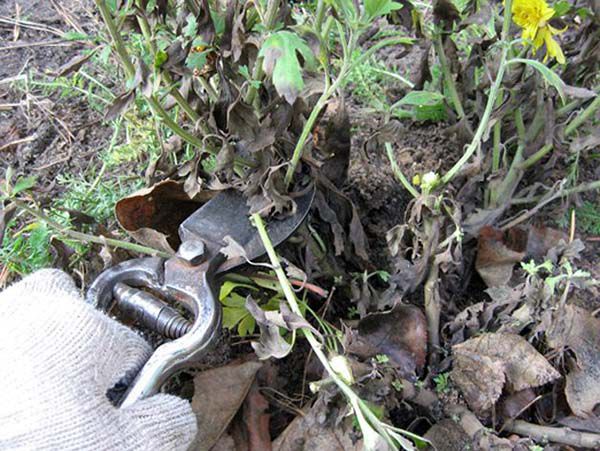

Chrysanthemum pruning
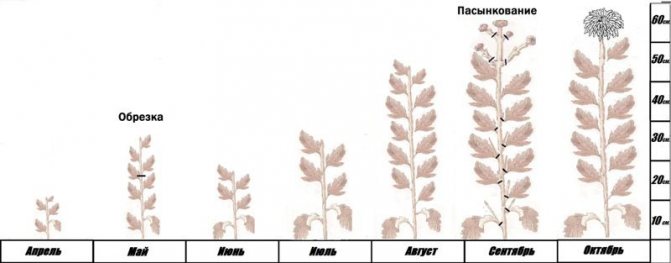

Chrysanthemum pruning scheme
Chrysanthemum in a pot, care after flowering
How to care for indoor potted chrysanthemums after flowering? When all the buds are dry, they should be removed. Also cut off any dry or damaged branches. After that, gradually reduce watering and place the flower in the place where it will winter.
If you want to achieve double flowering, then think about it in advance. In any case, you will have to organize the dormant conditions in which the plant will gain strength. After that, you can put the flower in the warmth ahead of time, increase watering, and also adjust the changes in daylight hours. All these measures can make the chrysanthemum bloom in late February and early March.
Chrysanthemums adore decor and fanciful containers, love the company of other potted plants and do not get lost even in the most colorful collection. Chrysanthemums are used to decorate gardens and terraces, facades and front gardens, balconies and apartments. All potted chrysanthemums have one thing in common - low winter hardiness. She determines the specifics of the cultivation of the main autumn soloists. Caring for indoor chrysanthemums is quite simple if you follow certain rules that you could familiarize yourself with in this article, as well as see photos of unpretentious domestic varieties that differ in the shape and color of the inflorescences. If there are other plants in the house, it is very important to arrange a so-called quarantine for the chrysanthemum for several weeks. Such a measure will allow her not to get infected from other flowers and adapt to new home conditions.
Features of home chrysanthemum
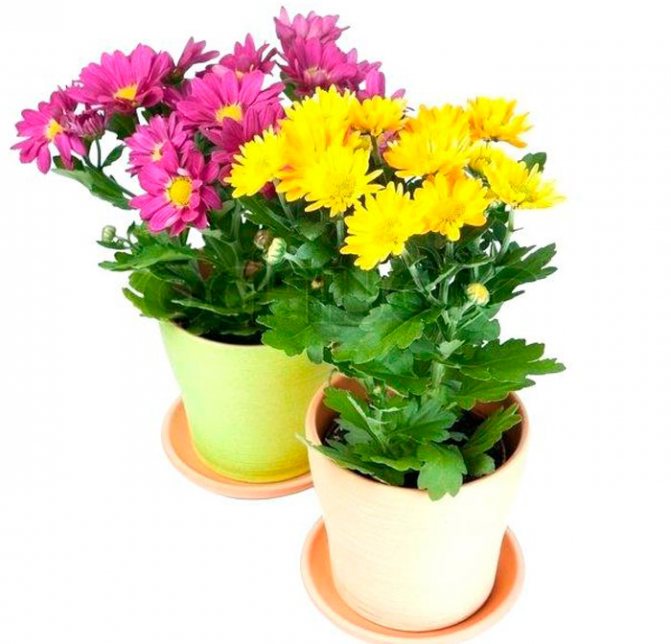

Home chrysanthemum is a compact and not very tall bush. The fact is that during its cultivation, special preparations are used that artificially stop growth. However, there were cases when garden-sized bushes grew from a purchased cutting of a home chrysanthemum.
As a rule, undersized varieties of Chinese chrysanthemum or mulberry chrysanthemum are grown in indoor conditions. The height of the lush flowering bushes can vary from 0.15 to 0.7 m. Their flowers are both large, reaching about 50 mm in diameter, and small (no more than 25 mm in diameter). And the varieties may also differ in the shape of the flowers. Also, some varieties of Indian and Korean chrysanthemums are cultivated at home by flower growers.
Indoor chrysanthemum blooms are usually observed in autumn and winter. In order for the bush to bloom as long as possible, it needs to be properly looked after, and it will also need special conditions for growth.
Required humidity
The flower loves watering well. But! waterlogging of the soil can lead to the death of the chrysanthemum. Putting a tray under the pot and periodically adding water there is also not the best solution. So, the flower will not be able to absorb all the moisture and will simply die. It is optimal to water the flower as needed: when the top layer of the soil in the pot dries up.
It should also be borne in mind that the plant requires daily spraying. Preferably in the morning. This is due to the fact that the indoor chrysanthemum is the same garden plant that, only, has adapted to indoor conditions, but is accustomed to dew.
Therefore, it should be additionally moistened. If it is not possible to do this, then you should get a humidifier, or put vessels with water next to it.


Bloom
Chrysanthemums bloom at home for a long time, more than a month. Flowering occurs in the autumn months. For a more lush flowering, during the growing season, until mid-August, it is necessary to pinch the shoots two or three times. In order for the plant to develop more actively and form a larger number of buds, use biological products that stimulate its growth, such as Bud, Epin, Zircon. It is believed that the use of a light solution of potassium humate contributes to the rapid growth of the plant, the growth of its root system and an increase in the number and size of buds.
In the future, during flowering, regularly cut off dried stems and faded buds so as not to create conditions for pests and not to spoil the decorative appearance of the bush.
What to do if the chrysanthemum has faded?
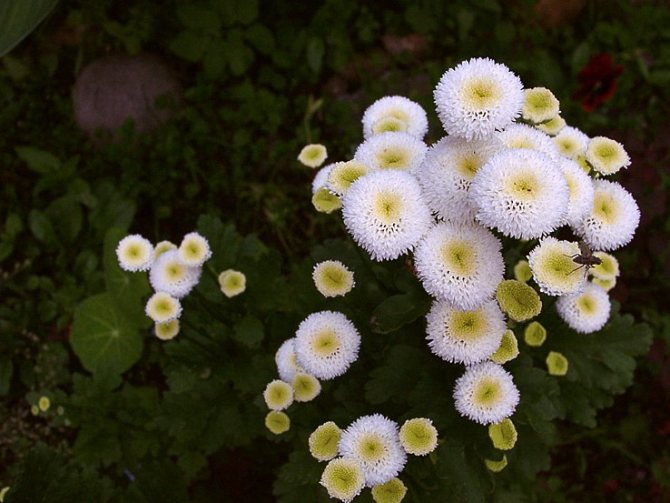

In natural conditions, after the chrysanthemums have faded, winter sets in. Bushes go into hibernation. You need to create something similar at home.
After your chrysanthemum has faded, cut off all its shoots to a height of 10 - 15 cm, weak and diseased - cut at the root. Water and store in a cool, dark place until spring. The temperature of its content in winter should be in the region from zero to three degrees. Such temperatures are maintained in cellars and basements in winter. There you will keep the flower until spring. In early spring, when the growth of new shoots begins, the plant is brought into the room, transplanted into new soil and placed on a well-lit windowsill.
If you do not have a basement or a suitable cellar, the chrysanthemum will have to be kept in some other suitable place during the winter. An insulated balcony, a glazed veranda or a window sill in the entrance, where the temperature will not exceed 8 grams, will do. Watering is almost not required, once during the entire wintering period will be enough.
If there is no cool room in the house, your chrysanthemum will have to spend the winter on the windowsill in the apartment, closer to the cold glasses. You also cut it off a little, remove all dry leaves, shoots, buds.Transplant into new nutrient soil. Take care of the flower as before - water it sparingly, do not let the root system dry out, but do not flood it either. Make sure that the bush is well lit from all sides - turn it in different directions to the sun. Ventilate the room. In a month and a half, your beauty will grow again. Form the crown - cut too long shoots, pinch them. Then the bush will become more luxuriant and form more buds. Feed him. Keep in mind that since you have deprived the chrysanthemum of a full-fledged winter rest, the flowering will not be as lush and long-lasting as the first time. After the next flowering, you will have to part with the flower or, nevertheless, organize a full-fledged rest break for it (put it in a cold place for the winter until spring).
Why didn't the chrysanthemum bloom?
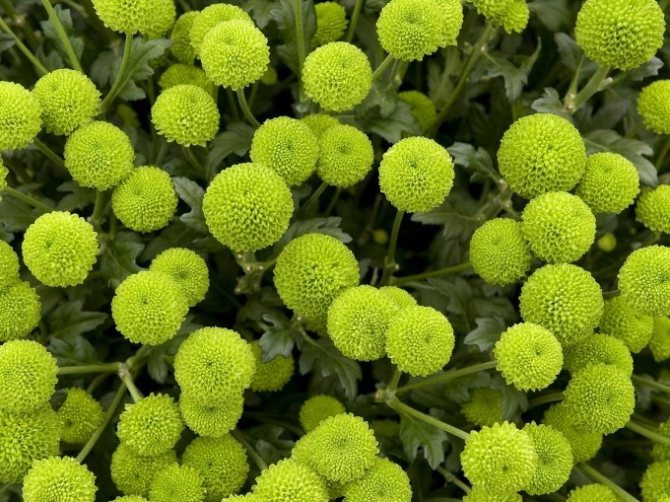

Everyone is waiting for the obligatory abundant flowering of the chrysanthemum bush in early autumn and even earlier. If flowering does not come at the right time, it means that you did something wrong during the many months of caring for the flower. Reasons that could cause the lack of flowering:
- insufficient lighting
- poor soil composition,
- lack of fertilizers or an excess of nitrogen content in them,
- late pruning of the bush, in which you cut the shoots with buds.
Analyze your actions, correct mistakes. If, in general, the bush is strong and healthy, next year it will certainly delight you with its magnificent flowering.
Trim / Support / Garter
During spring pruning in March, the long shoots of the plant are shortened to give the bush the correct spherical shape.
In addition to the formative pruning, you need to pinch the newly growing shoots. This is done throughout the growing season.
Pinching the bush turns out to be lush and attractive.... During flowering, dry flowers and yellow leaves should be removed to prolong flowering.
Temperature regimes
Potted chrysanthemums (both garden and indoor) love coolness, especially during the flowering stage. These are not the most heat-resistant crops that are comfortable only in typical autumn conditions. The higher the air temperature, the faster the inflorescences fade and the less chrysanthemums produce new buds.
That is why even miniature indoor plants are best kept outdoors during flowering. The optimal temperature regime for potted chrysanthemums is from 10-15 to 17-20 degrees Celsius or a little more.
If chrysanthemums are in temperatures above 21-22 degrees during the flowering period, they will not be able to normally lay buds for flowering next year, and even cold wintering will not give the expected effect.


Optimum temperature
The flower is well resistant to a wide variety of temperatures. But you still need to observe the regimes, depending on the time of year:
- Summer. 20-23 gr.
- Fall. About 16 gr.
- Winter. From -3 to 12 gr. So the flower will be in complete rest. In the future, this guarantees good flowering of the bush.
If the air temperature is below -3, then the roots of the flower may freeze and the plant will die.


Diseases and pests
Indoor chrysanthemum, the care of which is observed on all counts, is rarely subject to disease and is attacked by insects. It is the violation of the conditions of detention that provokes the disease or reduces the resistance to pests.
Diseases of the room chrysanthemum
Diseases affecting chrysanthemum, which can destroy the plant, are caused by harmful fungal spores, for which dampness is the best condition for development. Overdoing it with watering, the florist may after a while see signs of disease on the leaves of the chrysanthemum.
- Gray rot - the greens of the stems and leaves are covered with a fluffy gray bloom, under which the plant tissues decompose. Urgent measures - remove all affected areas, treat with fungicide, restore the correct regime and intensity of watering.
- Septoriasis - it can be identified by rounded dark spots with a light border. Growing up, specks cover the entire leaf plate of the chrysanthemum. Urgent measures - remove all affected leaves, treat the plant and the ground with copper sulfate, colloidal sulfur.
- Powdery mildew - a whitish bloom on the green parts of the bush. Treatment - fungicides ("Fundazol", "Topaz", "Skor", etc.)
Important! The earlier the treatment is started, the more chances are to save the chrysanthemum. If signs of illness are found, cut off all flowers and buds so that the plant does not waste precious energy on beauty when it is necessary to fight for life. Place the chrysanthemum separately from the rest of the plants for the entire treatment period until complete recovery. For prevention, treat all indoor flowers with fungicidal agents.
How to properly transplant a bush immediately after purchase
Only after acquiring a flower, it is necessary to create the most favorable conditions for it as soon as possible so that the adaptation period passes with the least harm to the chrysanthemum, and it continues to delight in the future with beautiful flowers.
The home view, in contrast to the garden, is highly dependent on sunlight. You must try not to flood the soil, otherwise the bush will die.
It is interesting: a purchased plant is sometimes transplanted into the garden, and taken back to the house for the winter.
All the plants bought in the store were grown in greenhouse conditions, which most of the inhabitants have no idea about. Therefore, experts recommend doing a transplant in order to facilitate the adaptation period for the flower. It is optional, but useful.
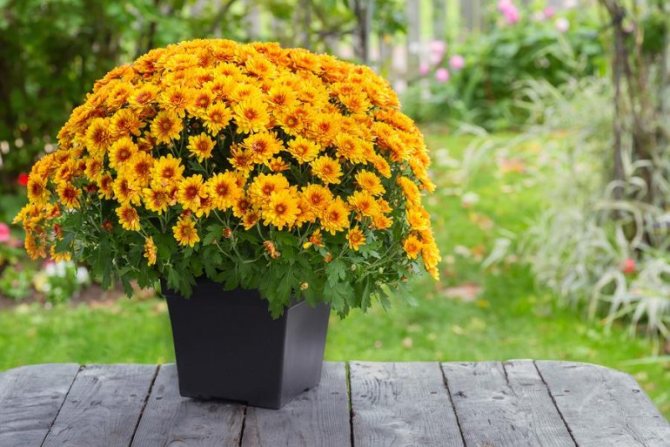

This should be done no earlier than 1.5-2 weeks after the appearance of the chrysanthemum in the new house. If you carry out the "resettlement" immediately, the bush may not withstand the double load imposed on it, and wither away.
First, the chrysanthemum adapts to the local microclimate with the old soil, and then it is planted in a new one.
The procedure is no different from the annual planned transplant for the purpose of renewal.
Handling culture after it appears in the home
After receiving a chrysanthemum as a gift or purchase, you do not need to rush to place it on the windowsill with other houseplants. The following guidelines must be followed:
- Inspect the plant for diseases or pests. If problems are found, treat with special preparations.
- Eliminate all damaged or withering leaves.
- Cut off the broken twigs.
- Place the chrysanthemum in a room where the temperature is 15 - 17 degrees.
- Keep the plant away from other indoor flowers for 10 to 14 days.
- After 2 weeks, transplant the culture into a pot with good quality soil.
Attention! Specially bred low-growing varieties are suitable for the house. Indian, Chinese, shrub and Korean types of chrysanthemums adapt well in the room.
Pruning and shaping bushes
For potted chrysanthemums, not one, but several scraps are needed:
- removal of wilting inflorescences that need to be removed from the bushes as quickly as possible;
- pinching the tops to form a dense and compact crown, which is carried out in spring and early summer 2-3 times;
- if desired, limit the height of the bushes or stimulate the second wave of flowering in winter - restraining pruning by 1/3 of the shoots;
- pruning before wintering, which is carried out to small stumps, removing all aerial parts.
Substrate for potted chrysanthemums: any soil mixture with a loose texture, admixture of sand and transfer (except sour).
Transplant time: perennial chrysanthemums are transplanted annually, old bushes - every two years immediately after signs of growth appear in the spring. Drainage is laid at the bottom of the tanks, the level of deepening is kept the same.
Watering
The purchased chrysanthemum must be watered carefully. On the one hand, this plant is quite demanding for watering. On the other hand, excess moisture can cause root rot or the development of fungal diseases.
To prevent this from happening, you need to ensure good drainage: a hole must be provided in the pot, and a layer of gravel or moss is arranged at the bottom. This will help remove any excess moisture from the pot.
- On average, chrysanthemum is watered no more than 2 times a week. You just need to make sure that the earthen lump does not dry out.
- Spraying the leaves is important and helps prevent dehydration.
- Dried leaves must be removed in a timely manner. And healthy leaves are regularly cleaned of dust.
For irrigation, you can not use ordinary tap water. You need to pass it through a filter and defend for a couple of days. The water should not be cold, otherwise the plant is threatened with disease.
sadovod.
Air humidity
Chrysanthemum prefers high humidity. Therefore, the plant should be sprayed regularly. The frequency of spraying is one (two) times a day. If the grower simply does not have a spray bottle, then you can simply put a saucer or a jar of water next to the home plantings.
Dust and dirt protection
Chrysanthemum leaves should be regularly wiped from dust and other contaminants that have accumulated on them. This can be done with an ordinary damp cloth. Some gardeners place the pot in the tub and gently wash away the accumulated dust with a shower head.
What to look for when buying
Chrysanthemums in the markets are presented in such a quantity that it is not easy to choose a single bush. But try to be very careful, because success directly depends on how picky you are.
Never buy chrysanthemums with fully blooming inflorescences - specimens in which inflorescences have bloomed no more than half will bloom better and longer.
The bushes should be fully formed, strong, the shoots should be woody from the bottom, and the leaves should be healthy. Please note that yellowing of foliage, spots on leaves and shoots are unacceptable.
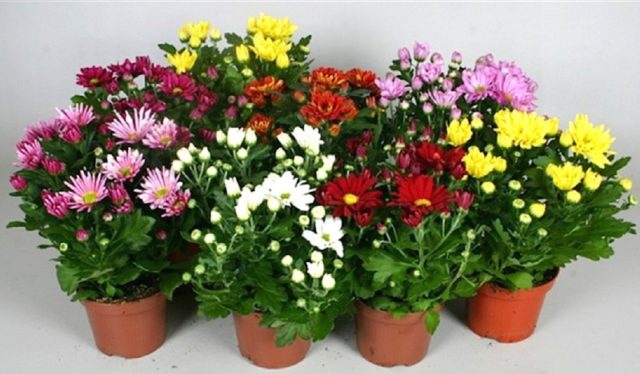

Wintering
To enjoy the flowering of chrysanthemums again and again, it is necessary to properly organize the wintering of the plant. It must be remembered that it develops cyclically. After flowering, just in the winter period of time, it goes into hibernation, as it were. It is then that you need to try to create the most comfortable conditions for her.
After the end of flowering, the chrysanthemum must be cut off. At the same time, leave only short stumps. Further, the pot must be placed in a room with a temperature of 0-5 grams. Watering is minimized, feeding too.
After the end of winter. If there are signs of spilling of the plant, it should be transferred to a cool, brightly lit room. Then you can transplant and start feeding and watering the flower. If the dormant period has passed comfortably for the chrysanthemum, then it will soon grow.
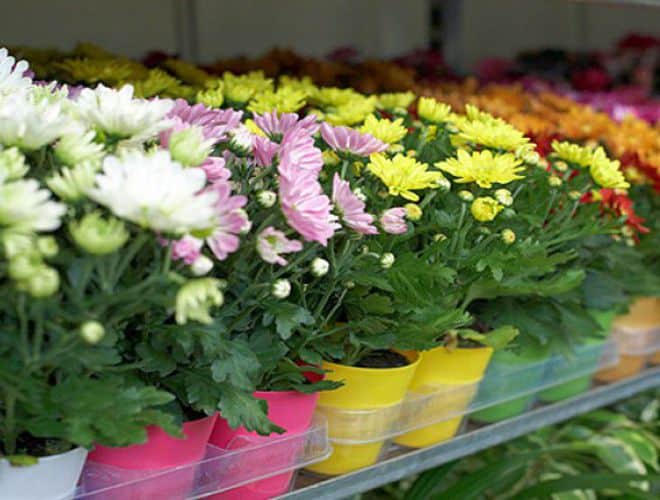

Care errors and their elimination
Problems in growing Chrysanthemums and their elimination:
| Problem | The reasons | Decision |
| Yellowing of leaves | Lack of light, lack of moisture, hot air | Place the flower in bright, diffused light, control the length of daylight hours, spray the leaves in the heat |
| Wilting leaves | Improper watering | Water the plant regularly, but in moderation, do not overmoisten or overdry the soil |
| Lack of flowering | Too hot air, poor soil, no pinching | Before flowering, lower the temperature to +15 degrees, apply complex fertilizers during the growing season, pinch the tops of the stems to stimulate the growth of lateral shoots |
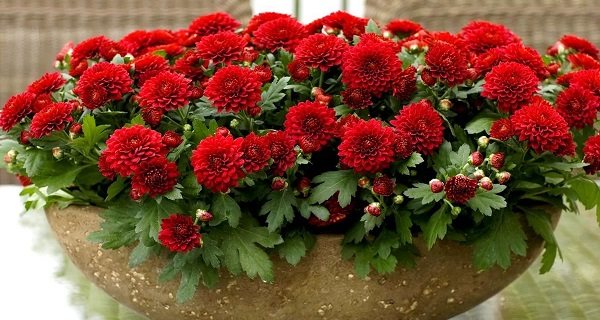

Possible Diseases - Why Chrysanthemum May Not Bloom
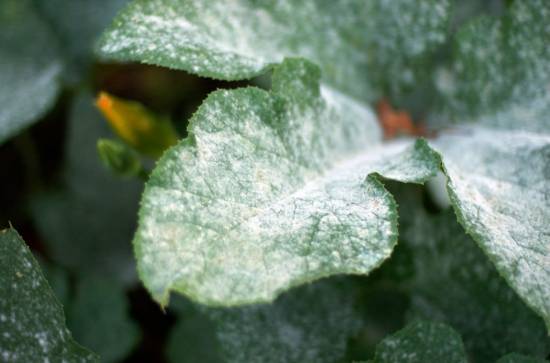

Without proper care, the flower can suffer
Chrysanthemum grows well and practically does not get sick. But due to improper care, the flower can still suffer. Among the main diseases are the following:
- Gray rot that appears as a fluffy coating or brown spots on leaves and stems. This disease is provoked by an increased level of humidity.
- Powdery mildew.It can be recognized by the white bloom on the buds and leaves. The cause is excessive moisture.
- Septoria is a lesion by fungal microorganisms. The disease can be detected by the dark brown spots on the leaves with a yellow border. It appears as a result of excessive use of nitrogen fertilizers.
- Spider mite. Its presence is evidenced by the light yellow color of the leaves.
- Aphids attack stem tops, leaves and buds. Damaged parts turn yellow and fall off.
- The thrips are located on the underside of the leaves, and light dots appear on top. The reason is low air humidity and high temperature levels.
Inadequate care can also be the reason for the lack of flowering. This happens under improper lighting. Chrysanthemum loves sunlight, but in moderation. Untimely germination can also lead to such consequences.
Chrysanthemum is an unpretentious culture. It can be successfully grown indoors. To cultivate a healthy and beautiful flower, you need to adhere to some rules regarding lighting, temperature, feeding and watering.
Chrysanthemums are unpretentious frost-resistant plants that are widespread almost everywhere. Today they can be easily found in any flower garden or botanical garden. The cultivation of these plants can delight with their bright colors until late autumn, in addition, they grow and take root very quickly. Many inexperienced gardeners are often worried about whether it is possible to plant a chrysanthemum in the fall, and how to do it correctly. After all, every florist knows that a lot depends on the choice of the place and time of planting for this flower. You can simply destroy the plant by choosing the wrong conditions for its living and growth.
planting and care
Shrubs of this flower are usually planted in autumn and spring. In addition, when carrying out this procedure in the autumn, it is necessary to take into account that the chrysanthemum definitely needs some time to take root. Planting chrysanthemums in the fall is a very responsible occupation that requires a special approach. First of all, you need to choose the right time. The period before the onset of winter cold should be at least twenty days. When planting, the plants try not to deepen, and a large amount of fertilizer must be applied to the pit. Five to six kilograms of compost, vermicompost, peat or humus will do. Fertilizers must be mixed with an equal amount of ordinary garden soil. After transplanting or planting chrysanthemums, it must be watered abundantly with warm water. Plants should be planted in such a way that the distance between them is from thirty to fifty centimeters.
It must be remembered that garden chrysanthemum, which can be planted both in spring and autumn, is very demanding for watering and loves water. That is why it must be watered abundantly and regularly with settled warm water. Violation of the regime causes a strong coarsening of the stalks of the chrysanthemum and affects its flowering: it reduces the size and brightness of the peduncles. The ground under the plant should always be slightly damp. However, overflow and stagnation of water must be avoided, otherwise the chrysanthemum may rot. In summer and spring, before the buds appear, you need to feed the plant with a large amount of nitrogen fertilizers, which will allow it to build up a large amount of green mass. You need to spend it every fifteen to twenty days. After the bush grows and hardens, the fertilizing is changed to phosphoric ones and which contribute to the abundant and prolonged flowering of chrysanthemums and increase their immunity. Also, sometimes a small amount is applied as an additional fertilizer
Planting a chrysanthemum in the fall is a rather difficult and dangerous process, because the correct development of a plant requires good nutrition and temperature during the first few months, when it intensively increases its vegetative mass. If you plant a flower too early, then it may begin to bloom and die during the cold weather, if it is too late, then its strength may not be enough for the winter period.If you have firmly decided that you need to plant a chrysanthemum in the fall, then the best advice would be to find a specialist who has already done this and knows how to choose the right time for planting, corresponding to your latitude.
Diseases of the room chrysanthemum
Frequent fungal diseases include verticillary wilting. This is one of the reasons why the leaves of the room chrysanthemum dry. Of these fungal diseases, one should be afraid and, and septoria, cause no less problems. Among the viral ailments, chrysanthemum is threatened by aspermia, dwarfism, ring spot and mosaic.
Chrysanthemums are unpretentious flowers, but in order for them to delight us with their beauty, you still need to know some of the secrets of caring for them.
The chrysanthemum has a peculiarity - during the growing season, it absorbs a large amount of nutrients from the soil, so it is advisable to transplant it to a new place. Transplanting any flowers, including chrysanthemums, is not an easy test for plants, and in order for them to quickly adapt to new conditions, everything must be done correctly.
So let's take a look at when and how to transplant popular fall flowers.
Planting a chrysanthemum from a bouquet
Some people believe that a presented bouquet of flowers in a vase cannot be reanimated, rooted and planted in the ground, otherwise trouble will await. However, this is not at all the case. After all, any cut flowers give joy. There is nothing better than to save and revive a faded flower and give it a second life. Therefore, to root the cut stalks of the chrysanthemum, they are cleaned of old leaves, cut off the faded buds and renew the cut of the branches. Further, the flower stems are placed in water with the Kornevin preparation for several days to speed up the germination process.
Chrysanthemum cuttings are planted, when the branches have started and given roots, in a loose, soil mixture that is sold in flower shops. If you wish, you can make it yourself. Several cuttings can be made from one chrysanthemum stem, their size should not be more than 10 cm. Each of them is planted in a separate pot and covered with a glass jar to create a greenhouse effect. It is very important to air the cuttings every day for 1-2 hours. If everything is done correctly, then the rooting of cuttings from the bouquet begins in two weeks. After that, the banks can be removed.
Getting ready to transplant chrysanthemum in spring
The undoubted advantage of the spring transplant is that in the spring the soil is much softer, which means that it will be easier for the root system to adapt to new conditions.
If you decide to transplant your pet in the spring, use the method of dividing the bush. First, the chrysanthemum must be carefully dug up, try to keep the roots, including the smallest ones, intact. After lightly shaking off the soil, divide the bush into parts, each should have shoots with roots. Otherwise, the algorithm of actions is the same as we described above.

